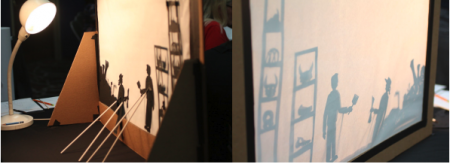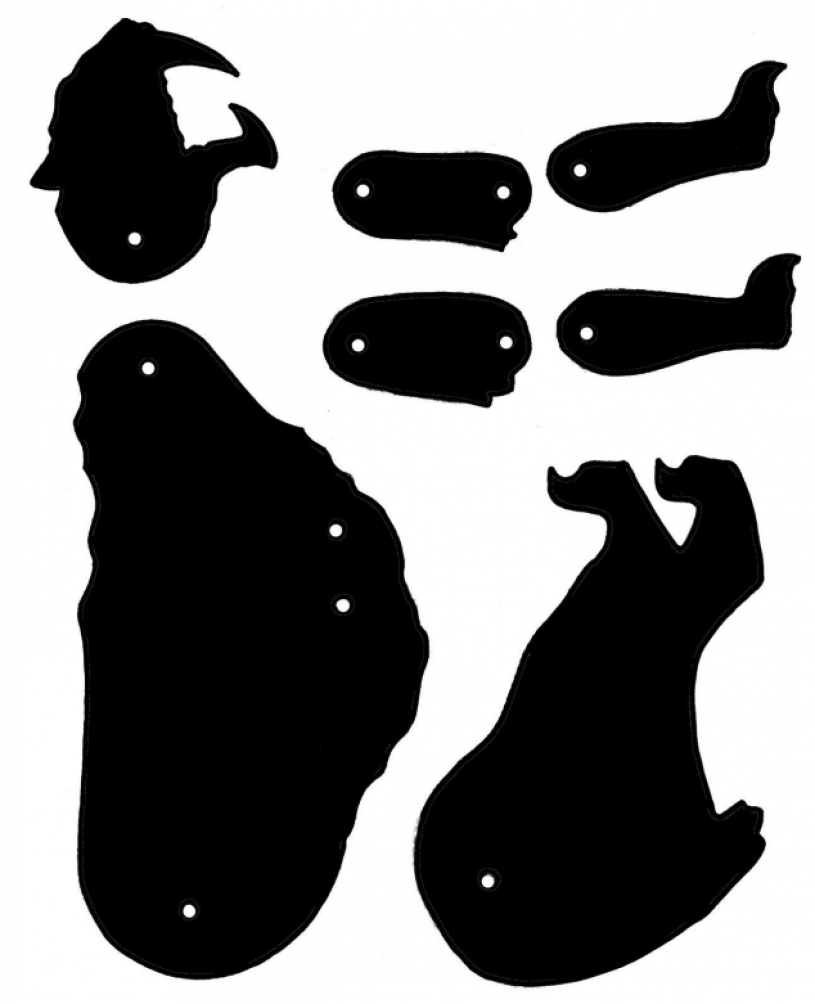Make Your Own Ice Age Shadow Puppet!
In this activity, you can make your own shadow puppet, inspired by the animals we find at La Brea Tar Pits!

Activity
In this activity, you can make your own shadow puppet, inspired by the animals we find at La Brea Tar Pits!
Materials:
- For Puppets:
- Black cardstock (or any cardstock if you already have it - including empty cereal boxes!)
- White-colored pencil or crayon (if using black cardstock)
- Pencil or marker
- 3/16" dowels (or use chopsticks, or cut off the sharp ends of BBQ skewers, or just sticks!)
- 1/8" brads (or string/yarn with the ends knotted on either end)
- 1/8" hole punch (or poke a smaller hole and use string or yarn to join)
- Tape
- Scissors
- For Stage:
- For tabletop setup:
- Cardboard or foam core (also try using a cardboard box)
- White butcher paper or parchment paper (or use 8.5" x 11" paper to make a small screen)
- Table Lamp
- For a larger setup:
- White sheet or shower curtain liner
- Something to drape curtain over (try a curtain rod in a doorway!)
- Standing lamp
- For tabletop setup:
Instructions:
1. Make a pattern.
Puppets can have joints or not. If you make a jointed puppet, consider where the joints will need to go for the most effective illustration of your movement. Joints on limbs should overlap the body of the puppet.
- Options for making a pattern:
- Create your own by sketching a character directly onto cardstock and cutting out the parts. Assemble with brads and dowels.
- Print an image, cut it out, and trace it onto cardstock, creating limbs and moving parts if you wish. Assemble with brads and dowels.
- Print our "Cali" saber-toothed cat puppet pattern, trace it onto cardstock (if available), cut it out and assemble with brads and dowels.
2. Cut Out & Assemble!
Punch holes where the limbs/moving parts should attach and insert brads. Tape dowels to sections of the puppet you want to control. Hint: some limbs work well on their own using the tabletop to create movement. For this cat puppet we put one dowel on the head, and one on the hindquarters. The front limbs crouched nicely on the table without any dowels. Place the puppet flat against your screen and control the limbs using a twisting motion.
3. Make some scenery elements.
Cut out shapes from cardstock or cardboard, or use some existing items such as artificial plants. Experiment with objects you have laying around! Lots of things at home can make interesting shadows to set your Ice Age scene!
4. Make your shadow screen.
For a tabletop setup, cut a rectangle out of the center of a large piece of cardboard or foam core (it should resemble a frame). Tape white butcher paper to one side of the frame, covering the entire opening. Cut two large triangles out of cardboard or foam core and glue or tape these to the back of your frame to make it stand up. Alternately, cut the bottom out of a shallow box (be sure to cut at least 1/2" inside the edges so the box will stand up!) and tape the paper over the opening. Position a table lamp behind and above the puppeteer.
5. Set up your screen, light your lamp, and perform!
Write a script! Improvise movements! Explore how the shadows change the size and move through space.
Example Scene:
- Characters: scientist, artist, fossils, and animal (example: saber-toothed cat!)
- Scenery: fossil dig site (rocks, crates, and tar pit); fossil lab (shelves of fossils, skeletons, tools); Ice Age landscape (trees, plants, tar pits)
- Story: Paleontologist excavates fossils from a tar pit. In the lab, scientists clean fossils, and technicians assemble bones. Artists work with scientists to create models of extinct creatures. That model is a creation that can come alive through puppetry!
Tips:
- Use facts and imagination to perform the movements of extinct animals (see below for fun fossil facts!)
- Puppets can interact with each other and their environment.
- Think about how your animal might have moved and try to copy that in your shadow puppet movements.
Saber-toothed Cat Facts:
Smilodon fatalis, or saber-toothed cat, is our California state fossil. Smildon is the second most common large mammal found at La Brea Tar Pits - excavators have uncovered more than 2,000 saber-toothed cats right here in Los Angeles!
Observe the skeleton and take note of distinguishing features such as the long saber-teeth, a hinged jaw that can open wide, and a short tail. Saber-toothed cats were ambush predators who crouched and pounced. Can you make your shadow puppet crouch and pounce?
Draw your own saber-toothed cat or print and cut out the template. What other puppets can you create




